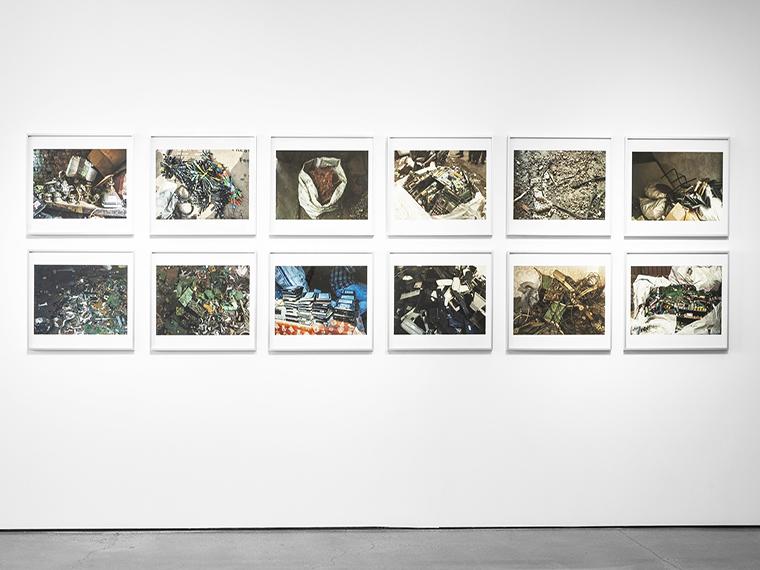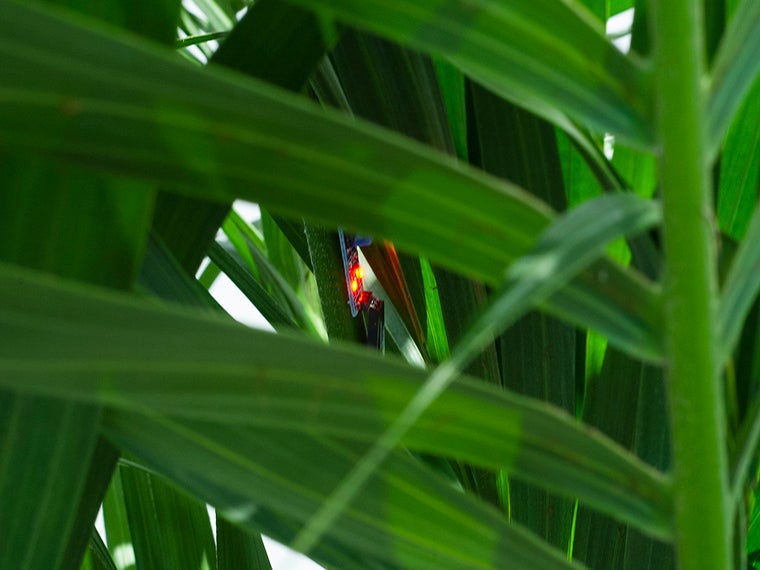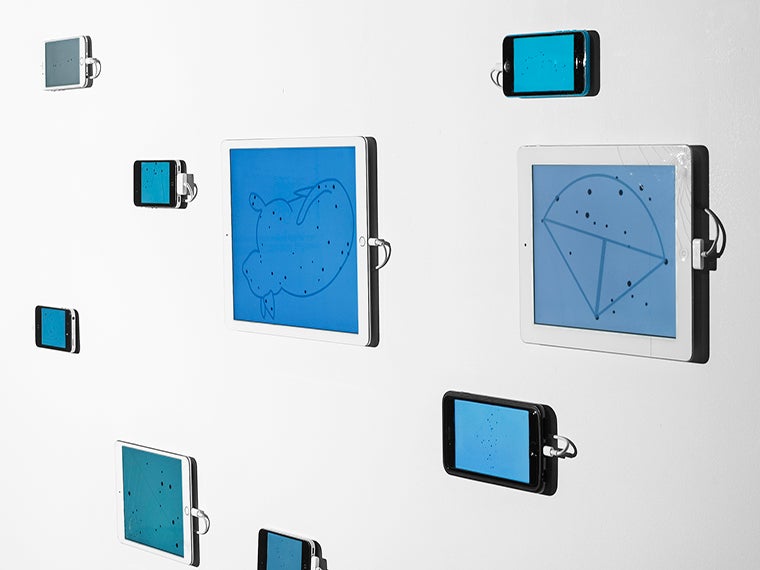Upgrade Available: A Conversation with Julia Christensen, Associate Professor of Integrated Media
October 27, 2020
Amanda Nagy

Julia Christensen's e-waste photography on display at ArtCenter College of Design.
Photo credit: Courtesy of Julia Christensen
Upgrade Available is a major umbrella project by Associate Professor of Integrated Media Julia Christensen. It includes a series of artworks, and now a book by the same name, published last spring by Dancing Foxes Press. An exhibition of Christensen’s photographs, drawings, and electronic installation—an interdisciplinary collaboration with scientists at NASA’s Jet Propulsion Laboratory—opened in September at ArtCenter College of Design in Pasadena, California, and is on view through December 20.
Since 2013, Christensen has been investigating narratives surrounding upgrade culture and how obsolescence impacts our experience of time. The resulting artwork and writing examines how the perceived need to endlessly upgrade electronics and recordable media to remain relevant affects our sense of time on many levels: in our daily lives, over our lifetimes, as institutional time, and lastly, in our perception of a space-time continuum.
Christensen’s more recent work with the Los Angeles County Museum of Art (LACMA) led her to a collaboration with scientists at NASA’s Jet Propulsion Laboratory, where she is helping envision long-term space mission concepts that defy our current measure of technological obsolescence. At JPL’s Innovation Foundry, she has collaborated on a project to develop a communication device that harnesses the electric currents in live trees. The Tree of Life mission has a 200-year operational lifespan and has been likened to a reimagining of the Voyager Golden Record, the Carl Sagan-curated record intended to communicate the diversity of life and culture of our planet to extraterrestrials.

Photo by Tanya Rosen-Jones
The book Upgrade Available features Christensen’s essays interspersed with her artworks and transcripts of conversations with artists, scholars, and experts from different fields. In this conversation, she shares the thought processes and the journey that took her from an e-waste facility in India to designing artwork that can tell the story of life on Earth for future interstellar spacecrafts. She also explains why it may or may not be possible for our global society to transcend obsolescence.
Q. The impetus for Upgrade Available started with your exploration of an electronic waste site in India. How did your collaborations lead you to NASA’s Jet Propulsion Lab (JPL)?
I started making this artwork investigating our complex relationships with electronics. This work led me to think about how upgrade culture relates to our personal and institutional archives and memories. Through my research I was introduced to scientists and engineers at JPL who are thinking about upgrade culture, too—but for them, it’s within the context of long-term space missions. How can we design a spacecraft that can travel light years away and still remain relevant in 50 or 100 years?
The scientists at JPL invited me to design an artwork concept that would be embedded on this spacecraft concept that is meant to travel to Proxima b in the Alpha Centauri star system. The idea is that the spacecraft will leave Earth in 2069. It’s 4.2 light years away from Earth, so it would arrive in the year 2111. We have to begin to develop technology now that would operate 40 years from now, and then would send data back 40 years beyond that.
Q. What does the Tree of Life project aim to accomplish?
The Tree of Life is a piece that generates the artwork that will be embedded on the future spacecraft. There are inherent issues of representation and all of these things about creating an artwork that tells a story about life on Earth. The question was, ‘Who else can tell us about life on Earth that would be longer and more encompassing than a story from a human being?’ I landed on the idea of harnessing the song of a series of trees to inscribe on a future spacecraft. What’s premiering in the show at ArtCenter right now is a series of trees with sensors on them that sense data related to light, water, and environment. Those data sets are being translated via a custom software into a song. The song of the trees is happening in real time in the gallery.
The idea is that over the course of the next 50 years, we will collect songs of the trees on Earth, and we’ll be able to inscribe them like a “Golden Record” on the side of these spacecrafts so they can be received by our as-of-yet-unknown cosmic neighbors. \
The second part of the Tree of Life is that one of the JPL telecommunications scientists found that you can harness the dielectric properties of trees and turn it into an actual antenna. This led us to ask if we can take the trees that are singing, and turn them into an antenna that is singing to a spacecraft. And can we actually design a spacecraft that can last as long as we need for the Proxmia b mission? This led to the design of a small CubeSat spacecraft that is conceptualized to last 200 years. So the trees are also antennas, and they are to be singing to a 200-year spacecraft. And that song is recorded, as well.
We wanted to design a project that had as much scientific integrity as well as artistic integrity. We didn’t want to design a spacecraft that just had some art slapped on the side or vice versa. From the beginning, we’ve wanted to grow this as a multidisciplinary art and science project. The scientific aim is to grow these long-term data sets that will tell us information that we wouldn’t get from a short-term experiment. Another exciting discovery is that when data is exhibited as sound; you can detect patterns that you wouldn’t see in numbers or even a drawing of the data because our ears experience the data in a different way.

Q. What is on display in your exhibition at ArtCenter?
In the exhibition, there are three bodies of photographs. The photographs are of obsolete technology in three different contexts. There are 12 photographs of the e-waste processing center in India. There are 12 photographs of institutional and personal archives—old VHS tapes, old boxes of DVDS. And there are 12 more photographs of pieces of obsolete technology embedded in a building, such as old ports and plugs. All of these are displayed next to each other. It’s all outdated technology, but it’s the context that makes the value of the trash different.
There is a series of 15 drawings that were all derived from 35mm slides from people who are deceased that I bought off ebay. Family members didn’t know what to do with these slides and sold them off. So I bought them, and I made these drawings to memorialize them with ink and paper.
There are some sculptural objects. The antenna prototype is on display, as well as the Tree of Life (there are three live trees singing), and my burnouts installation, which is a series of iphones and ipads that display images of retired constellations in the night sky.
Q: In your book, you talk about the impacts of upgrading and discarding. What does relentless upgrading mean for us in our daily lives? Why should we be concerned?
The book is a personal narrative that starts with me at an electronic waste facility and ends with me at JPL designing spacecraft that can transcend obsolescence.
When I first visited an e-waste processing center in India, I was floored by what I saw. It’s hard to describe the immensity. It became clear to me that our relationship to our ubiquitous devices is in no way connected to the global aggregate in our mind. There’s no way to conceptualize what an iPhone times 10 million looks like. It made me question the human end of this. What is it about our relationship to technology that perpetuates this unsustainable cycle?
Planned obsolescence and capitalism is the driver of all of this. My questions became, what is it that capitalism is able to exploit that is perpetuating this? The book looks at how we store our memories, how our memories are changing, and how we share and save our pictures; how institutions like LACMA store a cultural narrative over decades; and future-reaching scientific research and how we ask questions about the future using technology that we know won’t be relevant.

Courtesy of Julia Christensen.
Q. Your book includes conversations with various experts on the topic of obsolescence. From your vantage point, do you think it’s possible to completely transcend technological obsolescence?
That is partly what has been so exciting about my work at JPL. We have been harnessing rigorous interdisciplinary scientific and creative thought to do just that. It turns out, yes, we can design technology that lasts for hundreds of years. It’s a matter of whether or not we as a global society decide to. Obsolescence really is a choice. I can’t imagine that the market forces that perpetuate obsolescence would want to embrace long-lasting technology, but we’re reaching a critical juncture where something has to happen.

Julia Christensen
- Eva & John Young-Hunter Professor of Integrated Media
You may also like…
Friday Afternoon with Lab Crawl
This year’s Lab Crawl drew what may be the largest crowd in the event’s illustrious history, with some 500 students and dozens of faculty taking part. Missed out on the excitement? It looked something like this.
Lab Crawl: It’s Not Just for Scientists
Oct. 27 open house highlights research across the sciences—and just about everywhere else.
In the Path of Disaster
Monica Dix travels to a hub of natural calamity to probe its risks and resilience.


